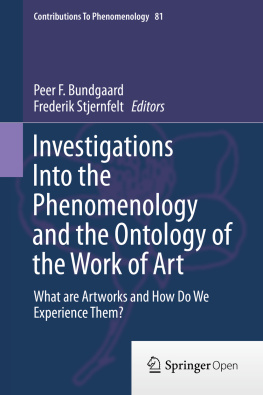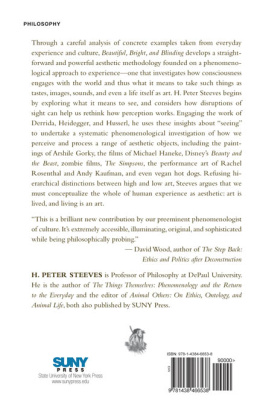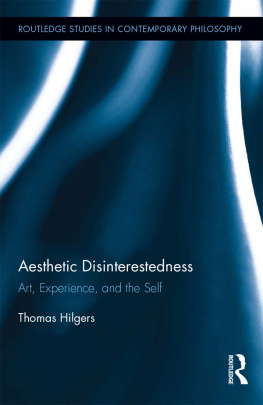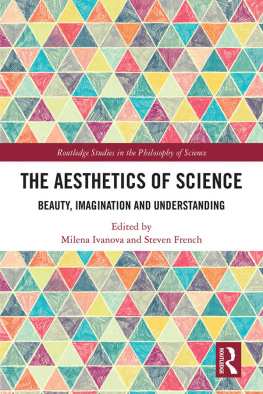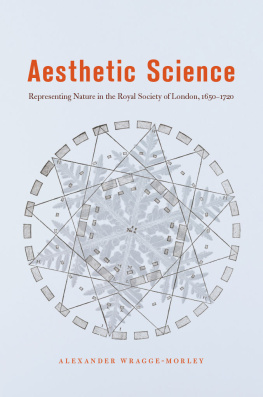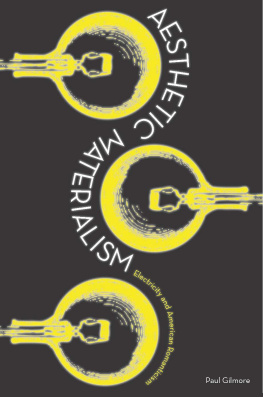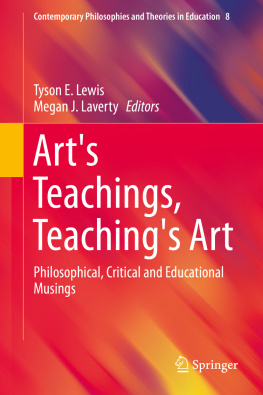The purpose of the present volume is to investigate the multifarious aspects of the relation between an artwork (visual, literary, or musical), its objective properties, the meaningful experience of it, and the cognitive skills and acts involved in the latter. Each of these aspects is a genuine and irreducible part of what I here will call the aesthetic complex, and each of them thus constitutes an autonomous domain of research or an object of scholarly interest: that certain visual or cognitive capacities are activated in the interaction with aesthetic objects; that the experience of aesthetic objects has a particular phenomenology, either because it is accompanied by an appreciative judgment (or a rewarding feeling) or because it is about a specific kind of object (artful objects); that artful objects have properties that plain objectsnatural as well as culturaldo not have; and, finally, that aesthetic objects manifest or represent a meaning in that they give shape to or embody an artistic meaning intention. The psychology, the phenomenology, the ontology, and the semiotics of the artwork each aims to lay down the above characteristics in each their domain, with each their methods.
The contributors to this volume are philosophers, psychologists, literary critics, and semioticians. As such, they address only one or just a couple of the abovementioned aspects. Each chapter will show, however, that the inquiry into one of the essential aspects of the aesthetic complex naturally raises research questions related to one of the other essential aspects. It is thus difficult to consider meaning-making in art without considering those structures and properties in artworks that embody that meaning or produce that meaning effect. Similarly, it is difficult to lay bare the essential properties of artworks (or of artful representation) without analyzing them in light of those properties of the human cognitive system or of the visual brain that make man particularly responsive to such qualities. In short, even though scholars, for obvious reasons, distribute their efforts selectively and focus their attention on one of the aspects of the aesthetic complex, these domains of inquiry are complementary.
With this volume we therefore hope not only to give the reader access to recent research within the ontology, the phenomenology, and the semiotics of the artwork, but also to manifest the complementarity of work done in each of these domains.
In the remainder of this Introduction, I shall first go into some more details with regards to the different aspects of what I have called the aesthetic complex and next give a short introduction to each of the chapters of the volume.
As the subtitle of this volume suggests What are Artworks, and How Do We Experience them? one can distinguish two correlates in the aesthetic complex: a subjective correlate, encompassing whatever relevant properties of the experiencing subject or whatever relevant goings-on in the cognitive system; and an objective correlate, concerning whatever relevant properties of the object likely to elicit a characteristic subjective response.
The emergence of Aesthetics as a philosophical discipline is coextensive with the discovery of the sensitive subject as the pivotal element of aesthetic experience. The object of inquiry becomesalready from Alexander Baumgartens Aesthetics (1750) and definitely with Kants Critique of the Power of Judgment ()the subjective correlate of the aesthetic complex, i.e., the cognitive dynamics activated in the viewer when perceiving artworks or when experiencing things considered beautiful, valuable, or of aesthetic interest. When Kant characterizes beauty in his Third Critique , he defines it not as a property of an object but as a feeling that is the outcome of a certain harmony of the faculties, a specific balance between certain cognitive centers (Imagination and Reason). Or, to use present day terms, a characteristic way of processing information that differs both in function and content from the way non-aesthetic information is processed.
In the same vein, Kant pinpoints another essential aspect of aesthetic experience that is exclusively subjective (not in the relativistic sense, but instead pertaining to the experiencing subject): the mental set in which the object is attended to, which is disinterested in that it does not pursue any theoretical (epistemic) or practical (moral) interest, nor does it pursue the fulfillment of any desire of any sort.
Whether Kant is right or not in claiming the disinterested nature of aesthetic experience is not important here. What matters are the two basic tenets of what could be called the Kantian legacy in aesthetics writ large: (1) aesthetic experience should be defined not in terms of the object that elicits the feeling of beauty but instead in terms of particular activation of the cognitive system; (2) subjects can attend to aesthetic objectsor objects deemed beautifulwithin an intentional framework (or a mind set) that is different from the framework through which we relate to objects for epistemic or moral purposes; (3) since aesthetic experience should not be understood and explained with reference to certain properties of an object and therefore does not require a specific competence for capturing those properties (both perceptually and intellectually), it is not the privilege of a particularly apt or trained section of the populationthe aesthetic subject is a general subject.
The philosophical and scientific enquiry into aesthetic experience which has developed in the wake of the Third Critique has, of course, not been Kantian through and through: the apriorism proper to Kants system, the complex mechanics that keep the harmony of the faculties together have not been part of most, if any, of the research programs in this domain. Many such programs can nevertheless be considered post-Kantian because: (1) the experiencing or sensitive subject is brought to the fore; (2) the feeling of beautyor, independently of the feeling of beauty, the experience of artworksis considered as being a specific cognitive response resting on general properties of the human mind, the visuo-cognitive system or human sensitivity in general, and therefore amenable to description or scientific description.
Marshaling such general positions, of course, does not warrant any unity, nor does it define a research program. With regards to point (2), there is considerable difference between approaching the response to beauty within Fechners empirical aesthetics (Fechner ). Yet, however different such research programs may be, they address a series of issues that are all related to the subjective correlate of aesthetic experience broadly taken (both as an experience accompanied by a rewarding feeling and as an experience of a specific kind of objects, namely artworks). Some of these questions are: if we attend to aesthetic objects differently than to plain everyday objects, then what characterizes this intentional attitude or mindset? If there is a difference between the phenomenology of seeing three apples, a photo of three apples, and a painting of three apples, then what characterizes the phenomenology of aesthetic experience? If artworks affect us perceptually by virtue of their qualitative (visual, textual, or acoustic) layout or design, what are the phenomenal or qualitative properties that are particularly significant for us and how do we process visual information (e.g., how do we reconstruct represented objects from depicting surfaces)? What attracts our attention or facilitates our memory when perceiving or reading artworks? If artworks affect us by virtue of given properties of our visuo-cognitive system, then what are the relevant properties exploited to that effect? If there is a specific phenomenology of aesthetic experience, does it follow that there is a general brain state or a neural dynamics that correspond to that phenomenology? If the feeling of beauty indeed often accompanies aesthetic experience, then how is it to be described? Is it a unitary response, triggered off by the same kind of stimuli for natural or biological reasons? Is it conventionally or socially imposed or is it idiosyncratic?

